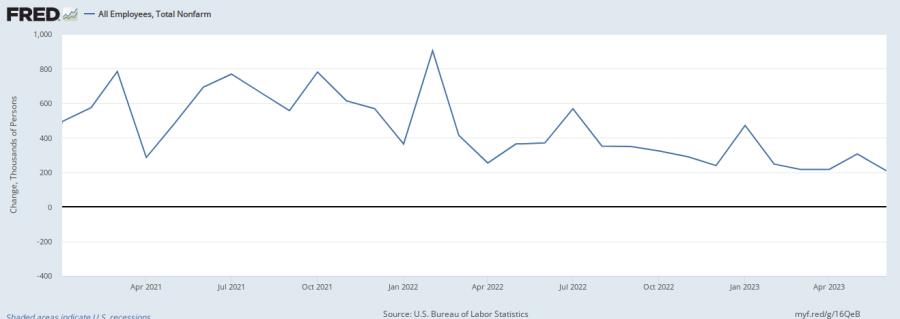Gregory Heym is Chief Economist at Brown Harris Stevens. His weekly series, The Line, covers new developments to the economy, including trends and forecasts. Read on for the latest report and subscribe here to receive The Line in your inbox.
Last week was the first Friday of the month, so today's all about jobs. I also definitively answer the "Will there be a recession this year" question. Spoiler alert!
Employment Growth Less than Expected in June
The U.S. added 209,000 jobs last month, less than the 240,000 estimate, but still a pretty good number. As with any data, it’s all about how you want to look at it. Job growth is clearly slowing, as you can see from this chart:

On the other hand, over the past 50 years we’ve added an average of 134,000 jobs per month, so this is way above average growth.
Here are the other headlines from the report:
- The government sector posted the highest job gain last month, adding 60,000 workers mostly at the state and local level.
- Employment in April and May was revised down by a total of 110,000. That said, that still leaves 523,000 jobs added in those two months. Not too shabby.
- The unemployment rate ticked down to 3.6%. Also, not too shabby. Great, now I have Adam Sandler’s voice stuck in my head.
- Wages rose 4.4% over the past year, which was slightly above expectations. The really good news here is that wages are finally rising faster than prices.
- The labor force participation rate remained at 62.6% for the fourth straight month. This is a bit troubling, as despite what you read in the news, many companies remain desperate for workers. So all you workers on the sidelines, it’s time to get back in the game, your economy needs you.
Job growth may have been a little disappointing this month, but it did remain strong. It’s always concerning when the government sector is responsible for almost 30% of the hiring in a month, as we’d much prefer the private sector to add the workers. That said, I wouldn’t be too worried about one month’s data, especially when the weather has been so nice.
In other labor market news, the number of job openings in the U.S. fell to 9.8 million at the end of May. While openings went down in May, they remain just under 10 million. The labor department has been collecting this data since the end of 2000, and during that time job openings have averaged 5.2 million per month, so this really is nothing to worry about.
We also got the latest on weekly jobless claims, which came in under expectations at 248,000. So, despite the continued talk of mass layoffs, the number of people actually filing for unemployment remains near historically low levels.
To sum up, the biggest problem in the labor market today remains the shortage of available workers, not the pace of hiring or layoffs. We should be grateful for the strength of the labor market, as it is the only thing that has kept us out of recession so far this year.
Two final things to end today’s discussion:
- The June jobs report won’t change the Fed’s plans, and I expect them to hike rates 25 basis points at their next two meetings.
- I’m very happy to admit I was wrong—and will be framing this column for my wife to enjoy— there will be no recession this year. There, I finally said it. My apologies to any of my loyal readers I may have upset by saying one was coming so often over the past few months.
